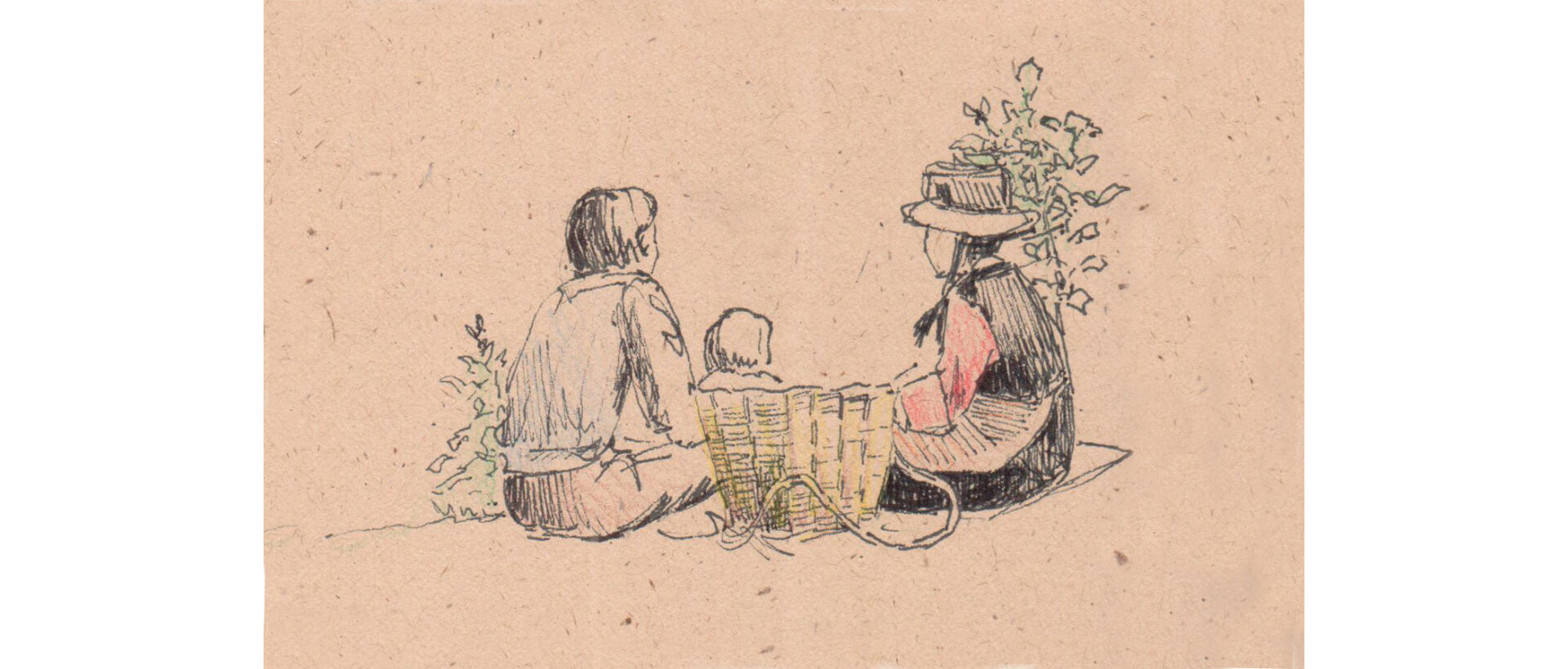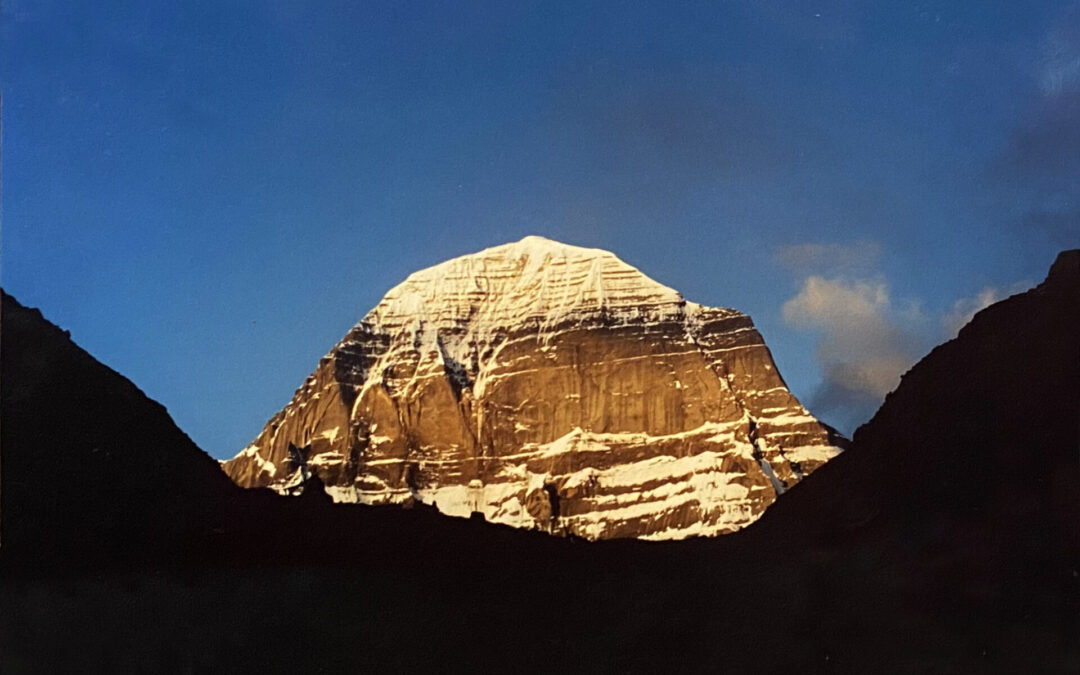
Travelogue: Trip to Mount Kailas in Tibet, 2000
Tuesday, June 6, 2000 • Kathmandu
We were to be downstairs in the hotel by 6:45am for tea—with luggage ready for the airport. Anticipation was high and many people were downstairs an hour before that. Lucy presented us with white shawls and we were off. Fifteen people. Twenty-six bags to check. All went smoothly at the airport. A bus drove us a very short distance to the tarmac to identify checked bags before they were loaded onto the plane.
Clouds followed us from Kathmandu, obscuring the sacred Himalayas as we flew to Lhasa. Dramatic mountains came into view on our descent. At 12,000 feet, Lhasa is one of the highest elevation cities in the world. (And you feel it as soon as you step out of the airport.)
The drive to the hotel from “Three Worlds” Airport was slow, maybe two hours. Rocky, sandy mountains in all directions. Blue sky with a constant show of cloud formations. Hundreds of army trucks. I was so happy to be in Tibet. The hotel is right under the expansive Potala Palace. Given the 2.5 hour time difference to Peking time, the day was short. “Lunch” was at 5:00pm. A tour guide led us halfway around the Palace and on to a bank to change money. People were tired and headachy and light-headed, so we decided not to finish the circumambulation, but to head back to the hotel a shorter way. Rain and wind chilled us, so we ducked into a hairdresser’s shop to wait out the storm. A huge rainbow brought us back out and elevated the rest of the walk.
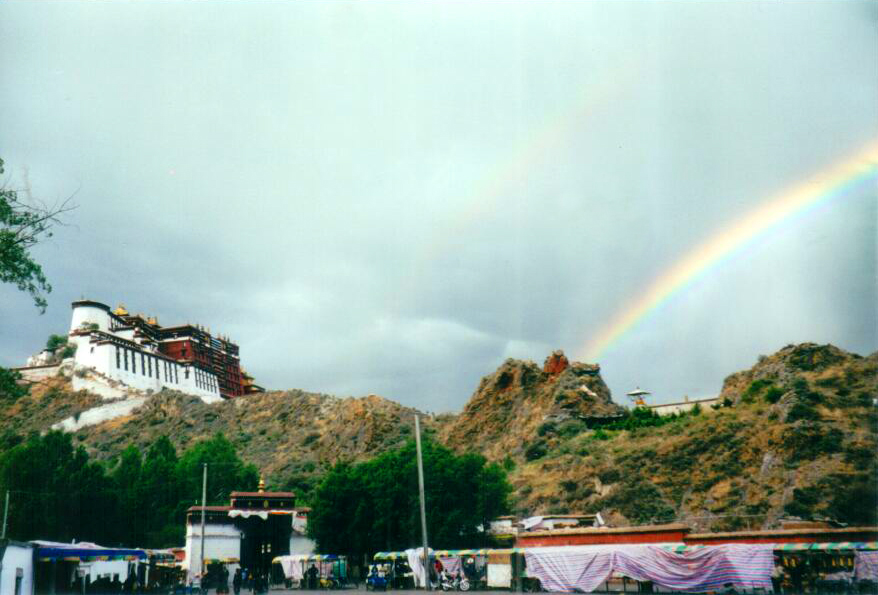
I have never seen such beautiful people. The Tibetans’ features are striking, augmented by an inner gentleness and strength. The shapes, the clothing are soon familiar. As we walked around the Palace beside the rows of spinning prayer wheels, many smilies were exchanged. I could feel the “Om Mani Padme Hum” flying around, soaring, filling the space with devotion. The monks’ deep voices chanted their prayers. The women, in groups of four, chanted in a beautiful contrast of rhythms. I could listen for hours.
Arriving back from the bank around 7:30pm we were informed of a dance performance at 8:00pm. I laid down and couldn’t rouse myself at 8:00pm. At 8:45 the music of the performance insisted. I am so glad I went down. Beautiful Tibetans of all ages in elaborate dress sang and danced traditional numbers for us—some from opera. The highlight was the yak dance—four dancers became two big furry yaks! Such a warm welcome to this special place!
Wednesday, June 7, Lhasa
7:00am Circumambulation of the Potala Palace. The whir of the prayers wheels is mesmerizing—you can feel the prayers rise into the air. I am already wishing we had more than three days in Lhasa. (The following is a snowy postcard, not as we saw the Potala Palace.)
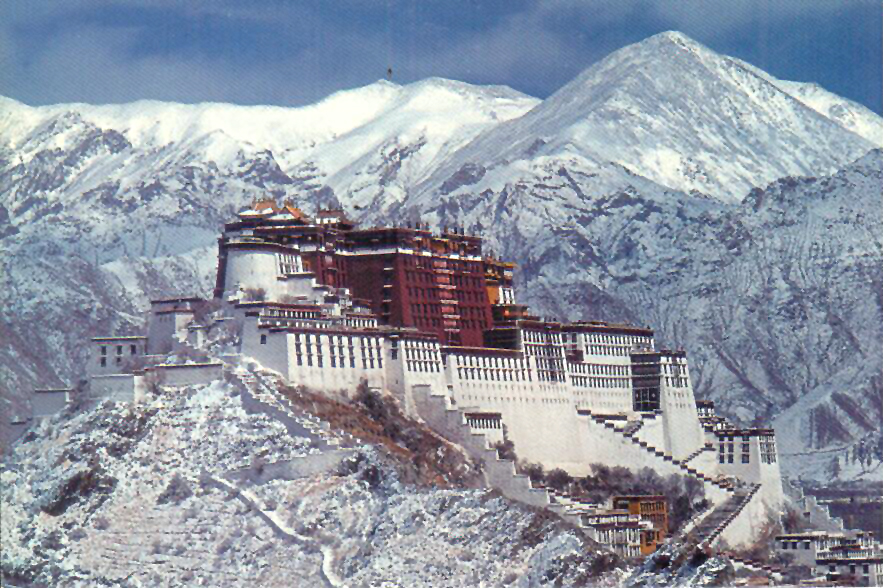

White toast with yak butter and strawberry jam for breakfast. Land Cruisers drove us the short distance up to the Potala Palace, the Dalai Lama’s winter Palace. Colors and patterns everywhere. There are 1,000 rooms and 10,000 shrines, decorated with 720 kilos of gold. It was begun in the 11th century and completed in 1645, and was named after the Potala Mountain in India. (Previously, I think it had been called Red Hill.) The walls of the entryway house a “pigeon-hole library”—cubbyholes all the way up to the high ceiling containing Tibetan translations of the Buddha’s teachings. So beautiful. We processed from room to room through corridors and sometimes up steep narrow steps. There were meditation rooms, altar rooms, meeting rooms…
Bigger-than-life-size figures were bedecked in turquoise inlay and other stones with delicate precision. The tomb of each Dalai Lama had a dedicated room. Butter lamps shone. An especially impressive “altar” was dedicated to the wheel of time. The symmetrical gold structure was ringed by seated figures. Something about it struck me deeply. In the presence of the remains of each Dalai Lama, I felt their power, their truth. We entered a large room and the tears that had been welling in my eyes streamed down my face. It was the Dalai Lama’s healing meditation room. Walls were filled with arched niches containing figures. The vibration is still very much alive. We had tea in the Dalai Lama’s walking meditation room.
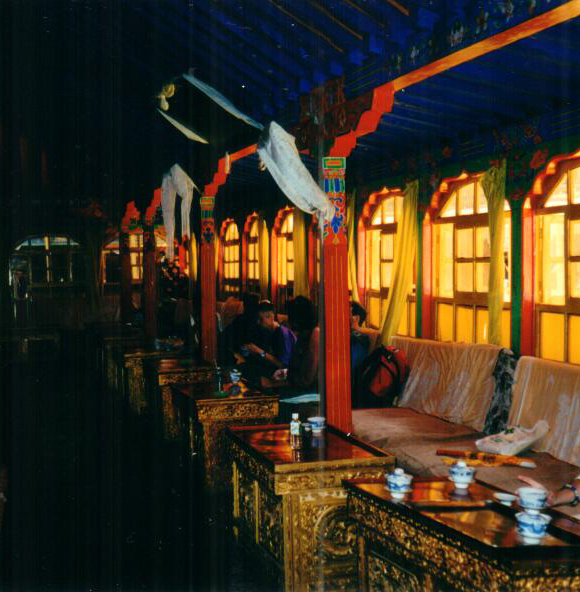
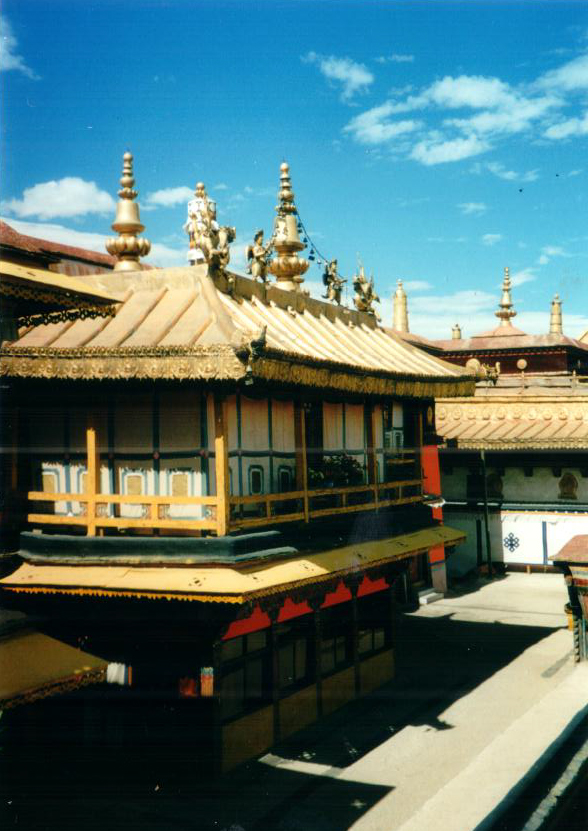
After lunch, we drove to Jokhang Temple and toured inside. We walked once around the inner circumambulation, prayer wheels whirring. Yoga class and satsang. No dinner. Ready to sleep.
Thursday, June 8, Lhasa
6:00am Satsang. 7:45am circumambulation of Potala Palace. Went slowly, spinning many of the prayer wheels. Toast and banana for breakfast—plus a pot of lemon ginger tea I had brought! Then went shopping for vegetables with Swami Vaisistananda; we were stocking up for a picnic lunch. In a big Chinese market, we found tahini with a delicious aroma to spread on bread. Swamiji was a pro at bargaining—joking with the vendors. Got good prices on carrots, cucumber, fresh peas and cauliflower.
Back just in time for 9:30am departure for Drepung Monastery. Got a taste of the dusty roads and the need for a face mask! The monastery was founded in 1416 and housed Dalai Lamas II–IV and other Lamas of the yellow hat sect. In the past, 10,000 monks studied here—now only 500. The main shrine of the Gandam Palace is dedicated to the Buddha of protection. For any donation, we received braided cords to wear around our necks for protection.
Firewood for the the monk’s kitchen used to be brought by a 60–70 yak “train” which would take 10 days to arrive!
Off at 3:00pm to the Summer Palace, a “small house” of 40 rooms built in 1959. The present Dalai Lama (XIV) left in 1959. It was sad to see his beautiful, empty meeting rooms. The main one had wall paintings illustrating history back to monkeys meditating in caves. His decorative meditation room and teaching room were so hauntingly empty… The grounds, however, were very peaceful.
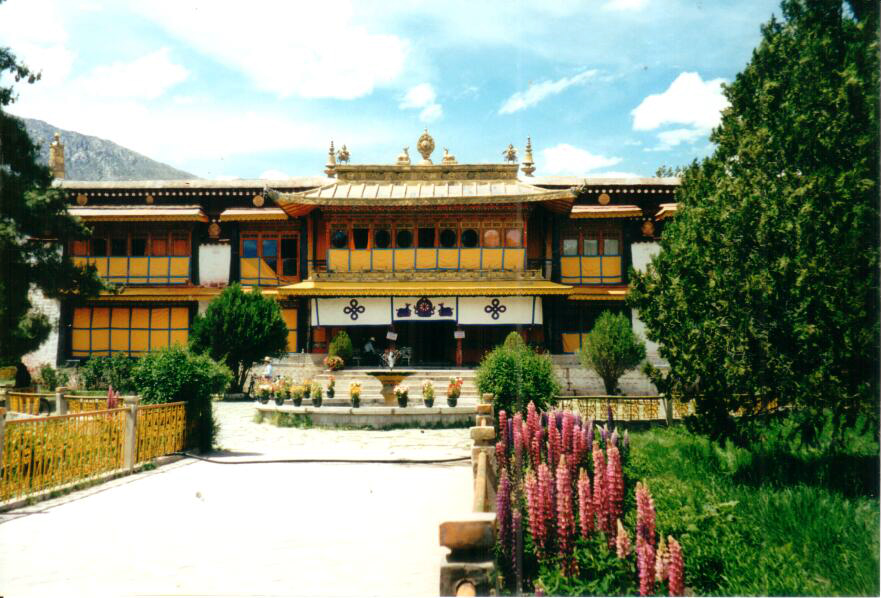
Back to the hotel for asanas at 5:00pm. At 6:00pm, we left for a restaurant near Jokhang Temple. Ate lots of vegetable momo (dumplings) and bobi (thin “crepes” with cheese spread and veggies). Jasmine tea washed it down well.
Went over to the temple afterwards and caught 15 minutes of the monks’ evening chanting. There were maybe 200 monks in their maroon robes on cushioned benches in varying shades of maroon among brightly decorated pillars. Easy to get lost in the vibration. We continued to a small chapel at the back, open for circumambulation.
An old monk sat on the floor chanting from the leaves of his prayer book, while a very young monk chanted along as best he could, craning his neck to see… Very sweet.
Tried to join the mass kora outside the temple, but there were so many people that we opted for the walk back to the hotel. Amazing clouds whooshing over the mountains.
Friday, June 9, Lhasa to Gyantse
Up early to finish packing. Loaded up the four Land Cruisers; Swami Vasishtananda performed a puja for the cars—sprinkled them with water and drew symbols on them with sandalwood paste. We did archanam of 108 names of Ganesha, while offering rice. We presented the drivers with official yatra t-shirts.
Had breakfast and then we were off—beginning our drive to the far west of Tibet to circumambulate the most sacred mountain. Parvati, Kailas, Rama and I will get to know each other well! Tiri, our driver for the next couple of weeks, is very sweet; he sings along with our bhajans.
Scenery is beautiful. Multicolor mountains in the distance and all around. Snow-capped mountains peek out. Not long after setting off on the twisty, dusty roads, one car had brake trouble. Thankfully, it did not cause much delay. We continued past fields of sheep, yaks, goats… stopped at a few stupas with player flags. Traditionally-clad Tibetans with decorated yaks and very cute children offered to let us sit on a yak for a photo—for 2 yuan! We resist, but certainly many photos are taken.
A thunderstorm threatened. The clouds seemed to make the sky even more amazing. I searched for a rainbow… caught glimpses of snowy mountaintops, maybe a lone Tibetan with a yak in the foreground. We passed many deserted Tibetan compounds on the south route of Friendship Highway, then came upon the sacred Yamdrok Lake with its intensely green water (100km from Lhasa).
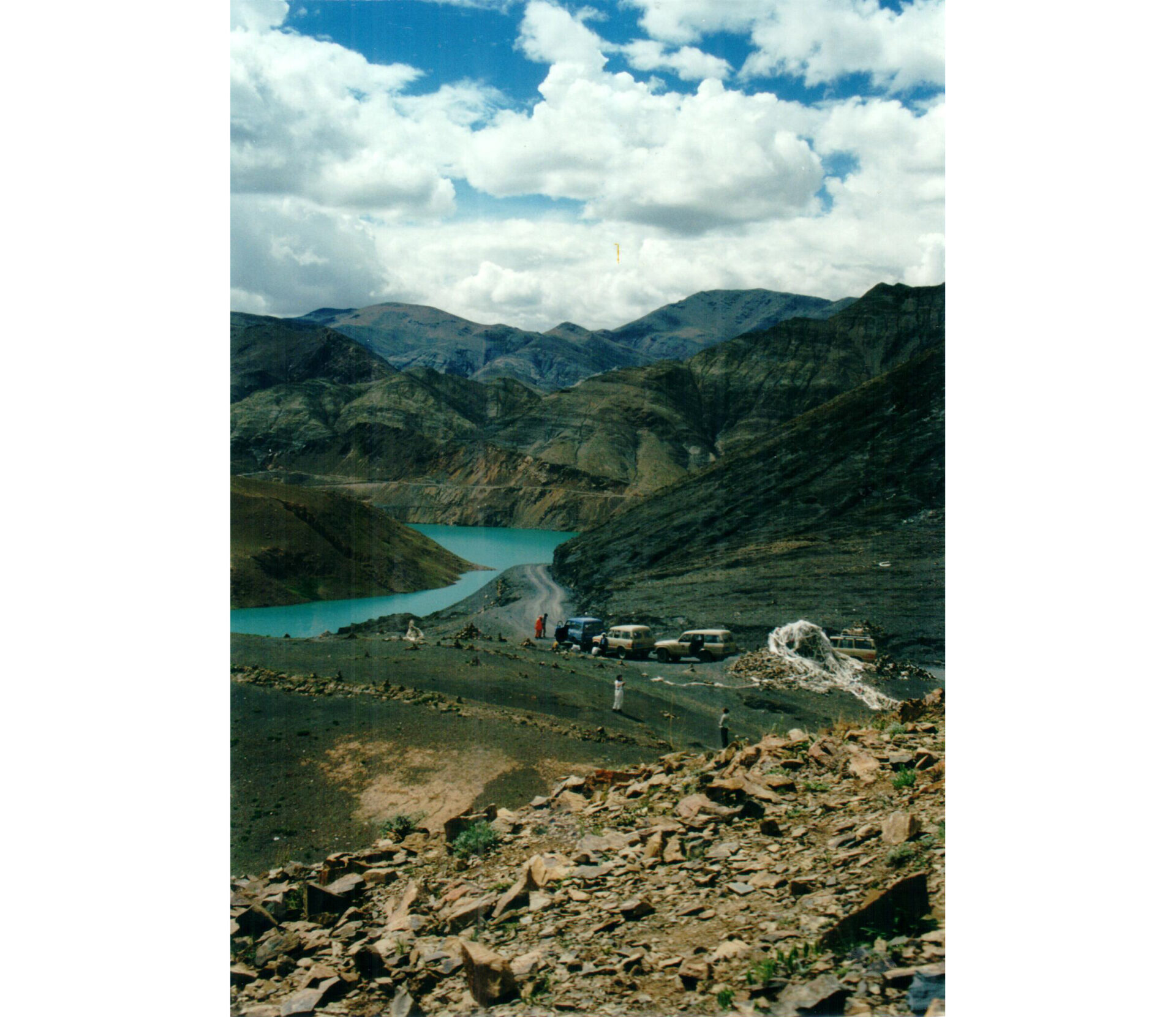
Back in the cars, we would wave as we passed folks from small villages, or road repair crews, or yak/sheep herders… We crossed a high pass (maybe 15,000 feet altitude) and arrived at the Wutse Hotel in Gyantse, elevation 4,040 meters (13,000 feet). I have dry nose and am feeling the lack of oxygen.
Saturday, June 10, Gyantse to Shigatse
Morning asana class was in the long, red-carpeted corridor outside the hotel rooms. From the Tashi Restaurant, we walked to the Kumbum and Pelkhor Chode Monastery. We circumambulated some of the seven levels of the Kumbum, a terraced stupa built in the early 1400s. Many small chapels radiate off on each level. Elaborate faces and figures appear as our eyes adjust from the sunlight to the darkness. A 15-day festival begins today. Maroon-clad monks sat in rows in the main temple. They chanted steadily. Some played drum, cymbals. One older monk was making mudras with his hands continuously as he chanted.
Across the dry yard, four girls were sifting gray powder through big screens. They sang so simply and beautifully as they worked. Impressive fort on a hill.
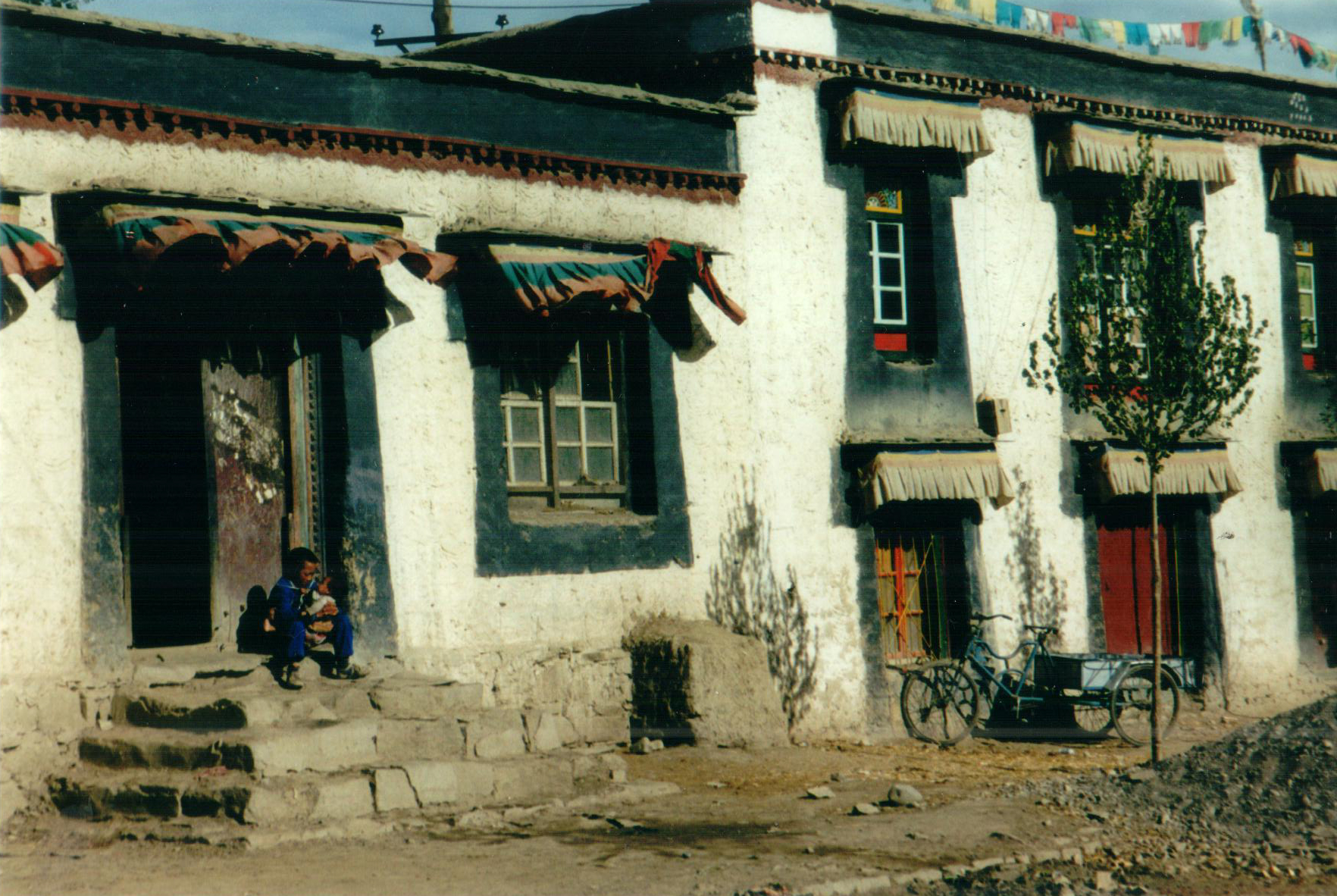
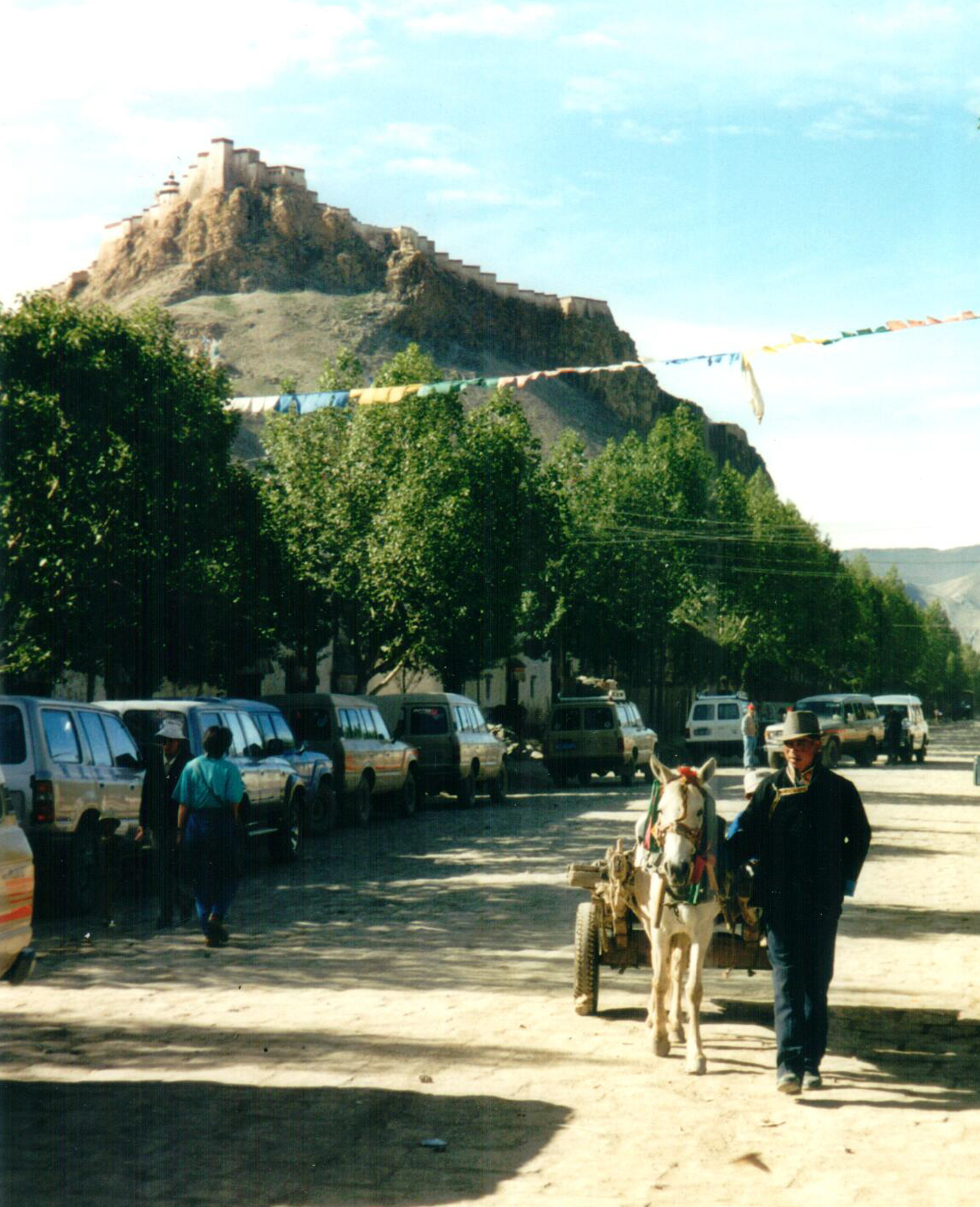
We drove a comparatively short distance today. Although it was pretty flat, there were mountains nearby on both sides. A 3-foot-wide stream flowed on each side of the dusty, rocky, rutted road. There was no snow in sight, just small villages once in a while, some field workers, a few trucks, a German tourist bus.
We arrived in Shigatse in time for 2:00pm lunch and then walked to the Tashi Lhunpo Monastery, founded in 1447. It is the seat for the Panchen Lamas. In Jamkhang Chenmo, there is a 28-meter-tall gilded copper Maitreya Buddha of compassion, with surrounding murals of 1,000 Buddhas.
The shrine built in 1989 for the 10th Panchen Lama was beautiful. The murals were impeccable. We were particularly drawn to a Durga Mandala. She has eyes in her palms and forearms, a halo of many tiny hands and quite a few feet and toes.
Among the picturesque alleyways and textures, we passed a platform strewn with monks woven “shoes”.
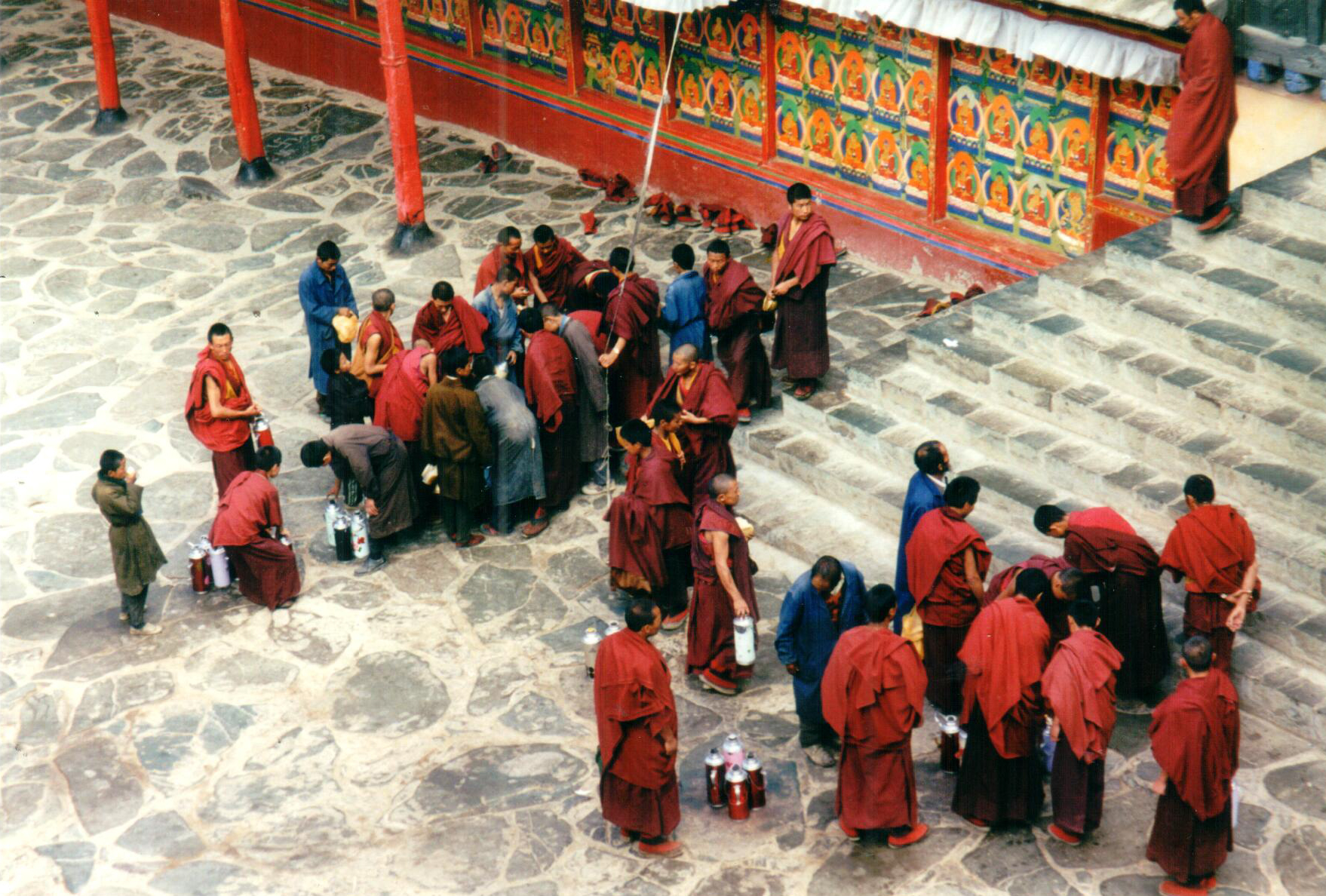
We then realized it was their tea time and watched from above as big copper spouted urns were brought out to fill the classic large thermoses.
We were then able to file into the hall where several hundred monks chanted underneath heavy worn, pleated ochre robes—all ages, all states of attention. A head monk passed through the aisles with a huge stick of incense. The energy was beautiful. It was truly a privilege to be there. Who are these men and boys? Can they keep this spirit alive? The monastery used to house nearly 5,000 monks. Today’s turnout seems to have to do with the 15-day festival beginning.
Yesterday’s singing in the car made me melancholy, thinking about past events in my life. And here I was today in remote Tibet, listening to the beauty of ages being kept alive by wise people.
